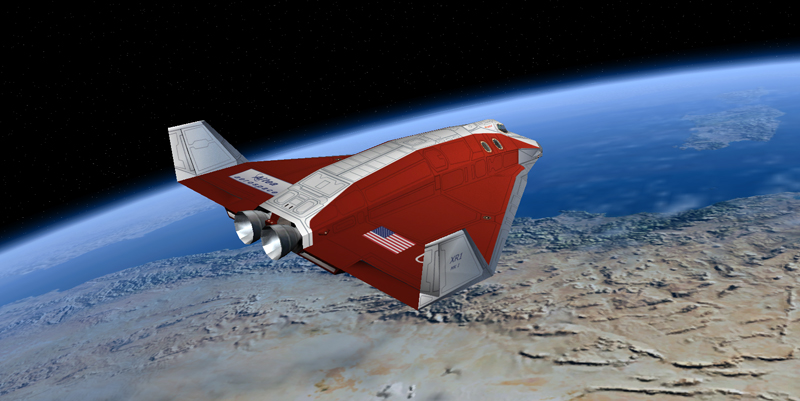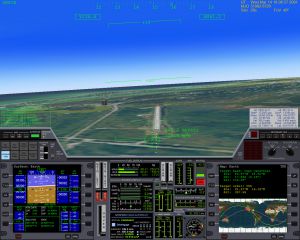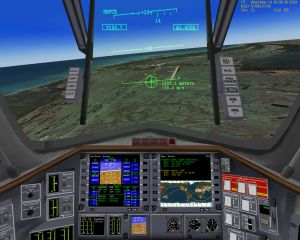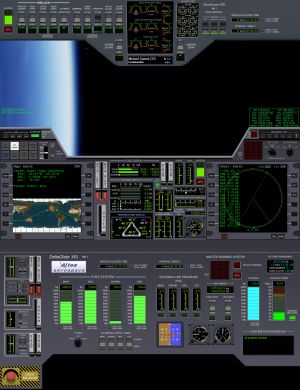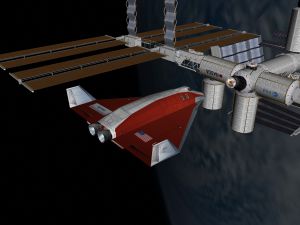Difference between revisions of "DeltaGlider-XR1"
m (→Summary) |
m (→Summary) |
||
| Line 2: | Line 2: | ||
The '''DeltaGlider-XR1''' (more commonly known as just "the XR1") is a new high-performance spacecraft for Orbiter that is a sophisticated rewrite of the DG-S mk-IV included with the Orbiter 2006 P1 release. Highlights include all-new instrument panels that support both 1280- and 1600-pixel-wide video modes, high-performance SCRAM engines, complex damage simulation, a virtual cockpit, numerous voice callouts, and new highly precise autopilots just to name a few. | The '''DeltaGlider-XR1''' (more commonly known as just "the XR1") is a new high-performance spacecraft for Orbiter that is a sophisticated rewrite of the DG-S mk-IV included with the Orbiter 2006 P1 release. Highlights include all-new instrument panels that support both 1280- and 1600-pixel-wide video modes, high-performance SCRAM engines, complex damage simulation, a virtual cockpit, numerous voice callouts, and new highly precise autopilots just to name a few. | ||
| − | + | ||
| − | |||
<br> | <br> | ||
The XR1 was designed to be a ''pilot's ship'', and with all the realism settings set to maximum the ship is significantly more challenging to fly efficiently (and ''safely'') than the default DeltaGlider; i.e., pilot workload is higher. However, the XR1 is fully configurable via the <code>Config\DeltaGliderXR1Prefs.cfg</code> file, and with all the realism settings disabled the XR1 is just as easy to fly as the default DeltaGlider. The configuration file also features a custom ''CHEATCODES'' section that allows the user to directly set certain ship's values such as maximum engine thrust, fuel capacity, ship mass, etc. | The XR1 was designed to be a ''pilot's ship'', and with all the realism settings set to maximum the ship is significantly more challenging to fly efficiently (and ''safely'') than the default DeltaGlider; i.e., pilot workload is higher. However, the XR1 is fully configurable via the <code>Config\DeltaGliderXR1Prefs.cfg</code> file, and with all the realism settings disabled the XR1 is just as easy to fly as the default DeltaGlider. The configuration file also features a custom ''CHEATCODES'' section that allows the user to directly set certain ship's values such as maximum engine thrust, fuel capacity, ship mass, etc. | ||
Revision as of 14:45, 11 June 2007
Summary
The DeltaGlider-XR1 (more commonly known as just "the XR1") is a new high-performance spacecraft for Orbiter that is a sophisticated rewrite of the DG-S mk-IV included with the Orbiter 2006 P1 release. Highlights include all-new instrument panels that support both 1280- and 1600-pixel-wide video modes, high-performance SCRAM engines, complex damage simulation, a virtual cockpit, numerous voice callouts, and new highly precise autopilots just to name a few.
The XR1 was designed to be a pilot's ship, and with all the realism settings set to maximum the ship is significantly more challenging to fly efficiently (and safely) than the default DeltaGlider; i.e., pilot workload is higher. However, the XR1 is fully configurable via the Config\DeltaGliderXR1Prefs.cfg file, and with all the realism settings disabled the XR1 is just as easy to fly as the default DeltaGlider. The configuration file also features a custom CHEATCODES section that allows the user to directly set certain ship's values such as maximum engine thrust, fuel capacity, ship mass, etc.
The XR1 was developed by Douglas Beachy and includes some custom mesh changes by Don Gallagher; the XR1's homepage is here: Doug's Orbiter Page
Features
- All-new instrument panels at native 1280x1024 resolution with 24-bit color. The main panel is low-profile in the center for maximum visibility.
- Virtual cockpit similar to the standard DG-S VC.
- Reentry heating simulation with realistic heat damage; e.g., overheating a hull surface will not cause that surface to fail instantly: the more a surface overheats, the higher the chances of a hull breach. Typical failure within eight seconds.
- SCRAM engine overheating damage simulation.
- Full configuration of the XR1's settings via the
DeltaGliderXR1Prefs.cfgfile; e.g., selectively disable/enable each different type of damage, set pop-up HUD colors and transparency, choose easy or realistic thrust levels, choose fuel setting for "ISS-only", "Moon", "Mars", etc., choose O2 and APU fuel levels.
- New [CHEATCODES] support in the DeltaGliderXR1Prefs.cfg file that allows you to directly set certain ship values such as the ship's mass, max engine thrust, fuel tank capacity, etc.
- New SCRAM and Hover doors using a custom mesh by Don Gallagher.
- New Multi-Display-Area (MDA) touch screen on the main instrument panel with multiple modes showing custom autopilots, hull temperatures, ship damage status, etc. For example, you can switch the readout between degrees Celsius, Kelvin, and Fahrenheit by clicking an area on the MDA screen.
- Efficient Attitude Hold autopilot to hold a given pitch/AOA and bank while neutralizing yaw; typically used during reentry or to hold attitude while braking with the hover engines in a vacuum. Autopilot can hold a stable reentry even at 10x time acceleration and can operate at 100x in space.
- Efficient Descent Hold and Auto-Land autopilot to hold a descent or ascent rate; engaging auto-land mode will land the XR1 in a hover efficiently and smoothly every time. With a good frame rate (~100 fps), autopilot can auto-land even at 80x time acceleration and can operate at 100x in space. This means you can auto-land the XR1 even with an effective frame rate of only 1.25 frames per second, and you can hold a set ascent/descent rate with an effective frame rate of only one frame per second.
- Efficient Airspeed Hold autopilot to hold a given airspeed within 0.1 meter-per-second. Useful during atmospheric flight and when taxiing.
- Reentry Systems Check MDA mode to verify that the ship is property configured for reentry.
- A new pop-up data HUD listing all the new XR1 keyboard shortcut keys.
- A new high-resolution exterior skin (1024x1024).
- Extensive damage and warning modeling including wing load limits, dynamic pressure and heat limits for different surfaces, and gear collapse on landing. Crew may be injured or killed by a hard landing or crash.
- Altitude, speed, damage, warning, failure, and docking distance callouts.
- Auxiliary Power Unit (APU) with (optionally) limited fuel that powers hydraulic systems such as flight control surfaces, landing gear, wheel brakes, etc.
- APU and O2 consumables management. Ship's mass is affected by LOX (Liquid Oxygen) and APU fuel loadouts in addition to main, RCS, and SCRAM fuel, and crew members.
- Internal systems coolant management; use the ship's radiator to cool internal systems. Overheating the system by waiting too long to deploy the radiator will cause internal systems to fail.
- Two pop-up mini-HUDs: secondary HUD is fully configurable and shows flight data such as altitude, airspeed, etc. in Metric and/or Imperial units. Tertiary HUD shows ship's status and warnings.
- Extensively tweaked flight model to allow realistic reentry at 40-degree AOA. Also fixed the unrealistic "floaty" feel to gliding and landing.
- Fixed the nose-up push that the stock DG exhibits when accelerating. The XR1 is much more neutral than the stock DG.
- Redesigned SCRAM (Supersonic RAMJET) engines that operate up to ~Mach 18. A good pilot can reach LEO with most of the main engine fuel remaining. Or if you're in a hurry, push both the SCRAM and main engines to full power and accelerate into orbit at 2.5 G's. The SCRAM engines are also useful after reentry if you are short of your landing site and don't have enough main engine fuel remaining (assuming you kept some SCRAM fuel in reserve!) New SCRAM engines operate at peak efficiency at Mach 7-8.
- 238 new sound effects and voice callouts; Requires the new OrbiterSound 3.5 release from DanSteph.
- New auto-starting Mission-Elapsed-Time (MET) timer plus two manual interval timers.
- Refueling and LOX resupply/dump support. Configurable settings for main fuel, APU fuel, SCRAM fuel, and LOX levels.
- Fuel cross-feed available between main and RCS tanks.
- 49-page XR1 Flight Operations Manual in PDF format along with screenshots.
- Support for the scenario editor.
- EVA and crew support via UMmu from DanSteph.
- High-polygon astronaut meshes developed by Greg Burch; used with permission.
- Astronaut mesh is easily configurable; users can use Greg Burch's high-polygon astronaut meshes, the standard bulky astronaut mesh included with UMmu, or any other custom astronaut mesh.
For additional details refer to the XR1 Flight Operations Manual
